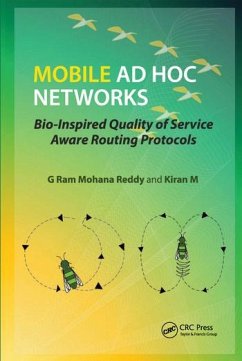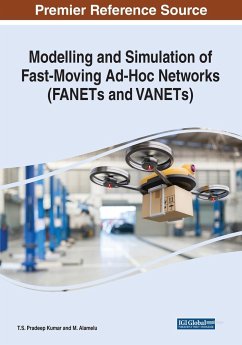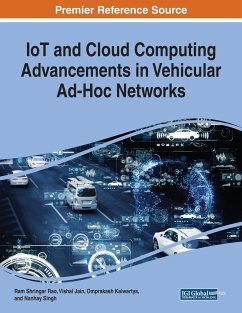
Evaluation of the Effects of Predicted Associativity on the Reliability and Performance of Mobile Ad Hoc Networks
Versandkostenfrei!
Versandfertig in über 4 Wochen
17,99 €
inkl. MwSt.
Weitere Ausgaben:

PAYBACK Punkte
9 °P sammeln!
Routing in Mobile Ad Hoc Networks (MANETs) presents unique challenges not encountered in conventional networks. Limitations in bandwidth and power as well as a dynamic network topology must all be addressed in MANET routing protocols. Predicted Associativity Routing (PAR) is a custom routing protocol designed to address reliability in MANETs. By collecting associativity information on links, PAR calculates the expected lifetime of neighboring links. During route discovery, nodes use this expected lifetime, and their neighbor's connectivity to determine a residual lifetime. The routes are selec...
Routing in Mobile Ad Hoc Networks (MANETs) presents unique challenges not encountered in conventional networks. Limitations in bandwidth and power as well as a dynamic network topology must all be addressed in MANET routing protocols. Predicted Associativity Routing (PAR) is a custom routing protocol designed to address reliability in MANETs. By collecting associativity information on links, PAR calculates the expected lifetime of neighboring links. During route discovery, nodes use this expected lifetime, and their neighbor's connectivity to determine a residual lifetime. The routes are selected from those with the longest remaining lifetimes. Thus, PAR attempts to extend the duration routes are active, thereby improving their reliability. PAR is compared to Ad Hoc On-Demand Distance Vector Routing (AODV) using a variety of reliability and performance metrics. Despite its focus on reliability, PAR does not provide more reliable routes. Rather, AODV produces routes which last as much as three times longer than PAR. However PAR, even with shorter lasting routes, delivers more data and has greater throughput. Both protocols are affected most by the node density of the networks. Node density accounts for 48.62% of the variation in route lifetime in AODV, and 70.66% of the variation in PAR. As node density increases from 25 to 75 nodes route lifetimes are halved, while throughput increases drastically with the increased routing overhead. Furthermore, PAR increases end-to-end delay, while AODV displays better efficiency. This work has been selected by scholars as being culturally important, and is part of the knowledge base of civilization as we know it. This work was reproduced from the original artifact, and remains as true to the original work as possible. Therefore, you will see the original copyright references, library stamps (as most of these works have been housed in our most important libraries around the world), and other notations in the work. This work is in the public domain in the United States of America, and possibly other nations. Within the United States, you may freely copy and distribute this work, as no entity (individual or corporate) has a copyright on the body of the work. As a reproduction of a historical artifact, this work may contain missing or blurred pages, poor pictures, errant marks, etc. Scholars believe, and we concur, that this work is important enough to be preserved, reproduced, and made generally available to the public. We appreciate your support of the preservation process, and thank you for being an important part of keeping this knowledge alive and relevant.












